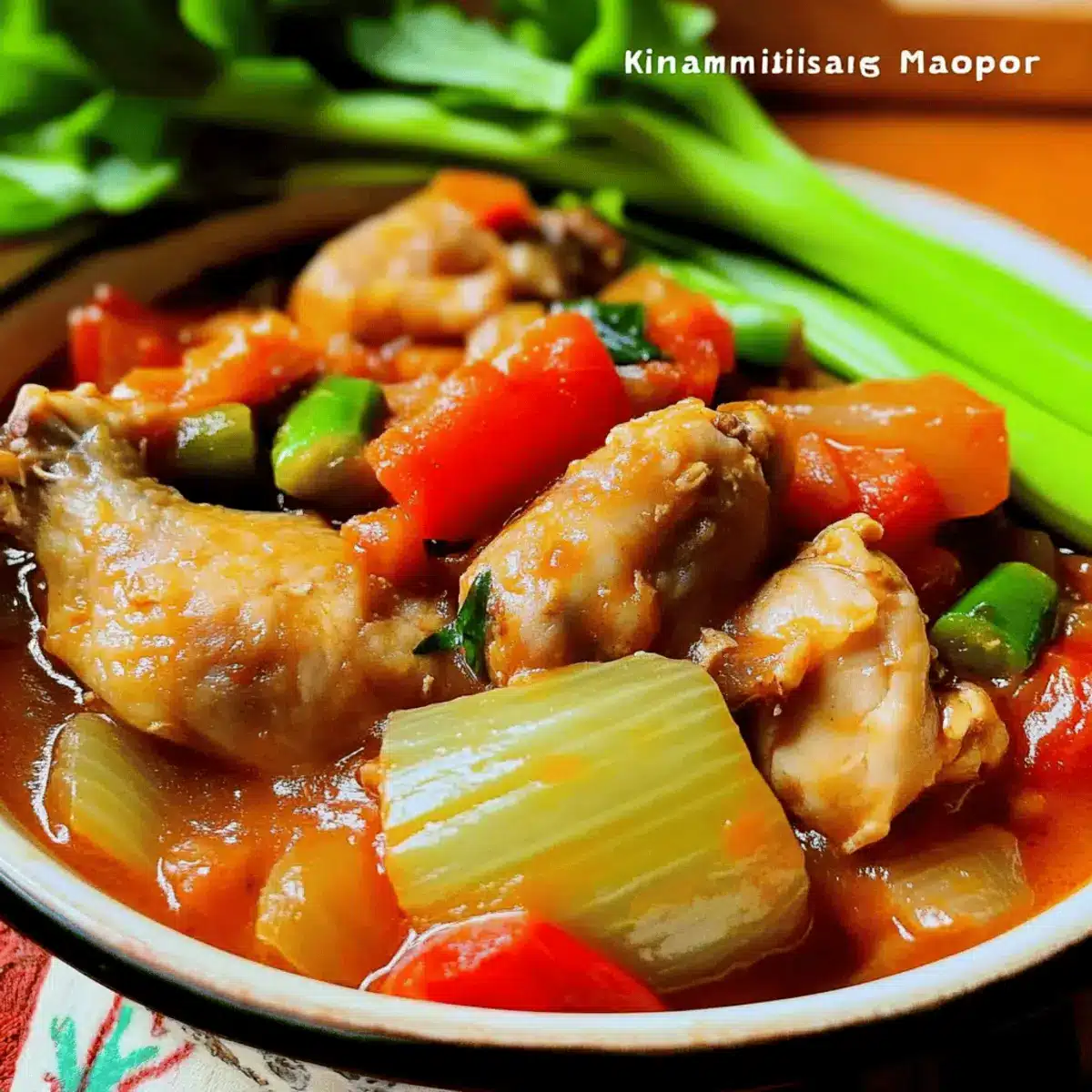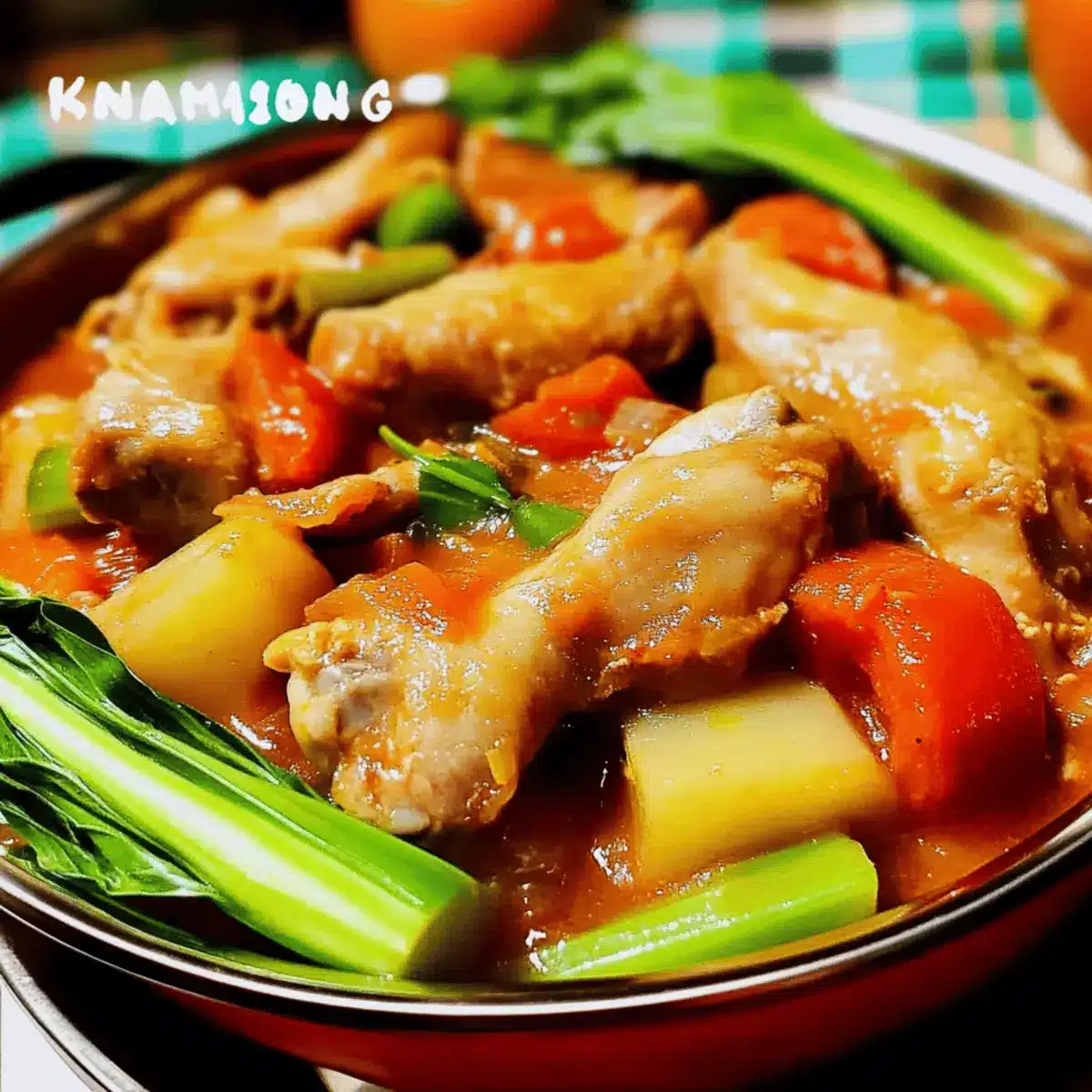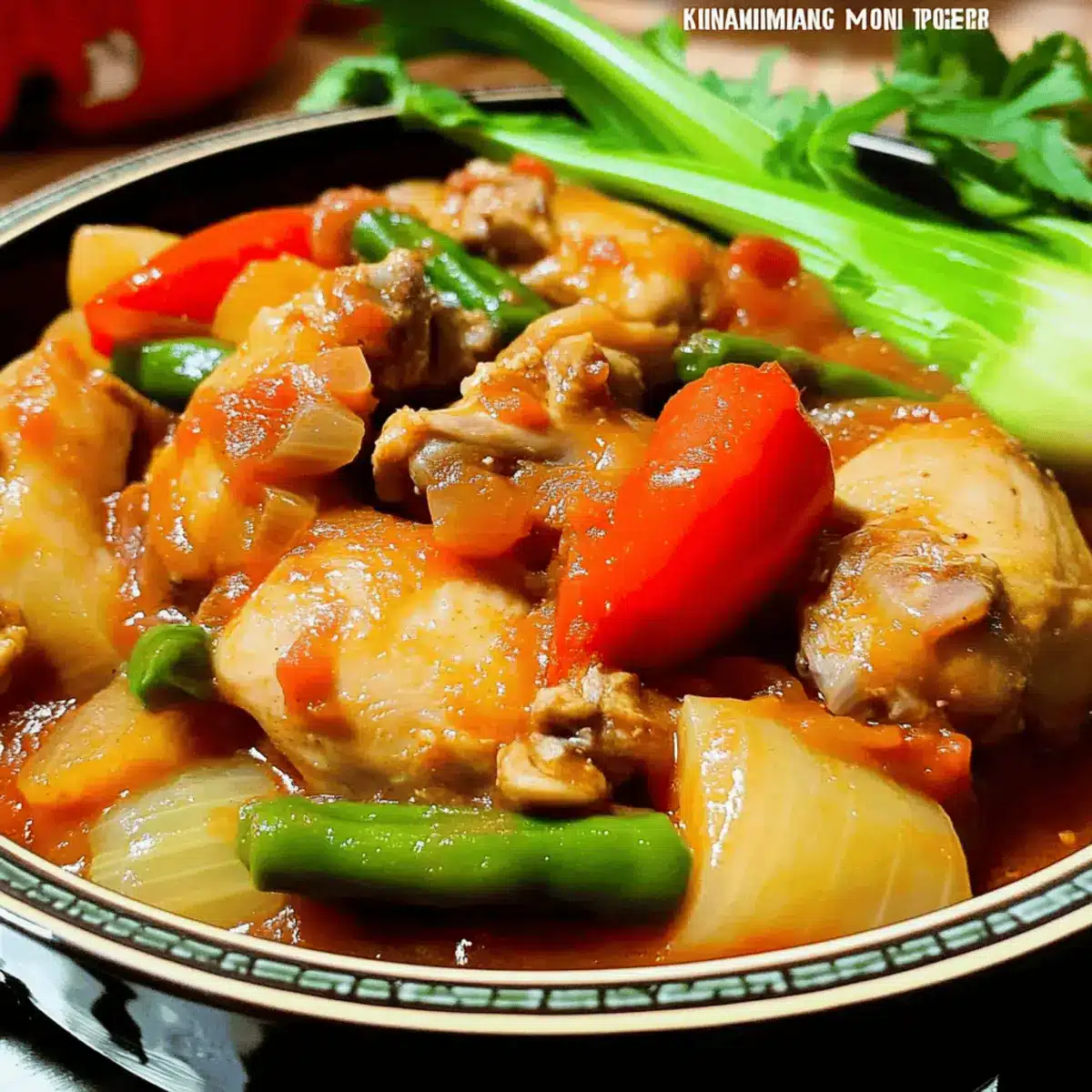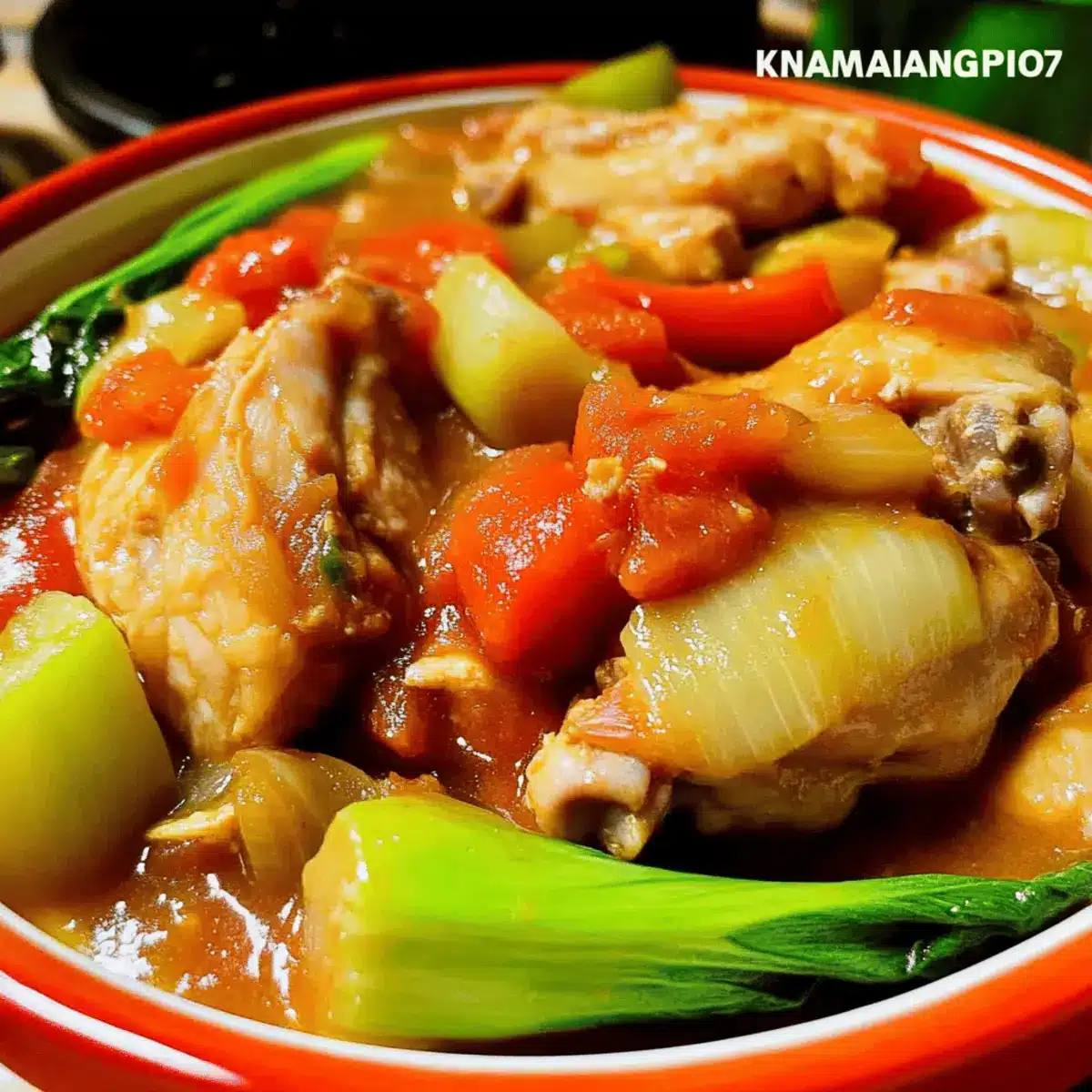It started with a simple desire to bring warmth to a chilly evening when I stumbled upon a pot of kinamatisang manok simmering on the stove, its savory aroma wrapping around me like a cozy blanket. This Filipino chicken stew with tomatoes not only warmed my heart but quickly became a staple in my kitchen. Kinamatisang manok is a delightful combination of tender chicken slowly cooked in a luscious, tomato-based sauce infused with garlic, onion, and ginger. It’s the perfect solution for busy weeknights, allowing you to serve up a comforting meal that the entire family will adore! With minimal prep and ingredients that bring vibrant flavors together, this dish is a culinary hug in a bowl. Curious about how to make this heartwarming stew? Let’s dive right in!

Why is Kinamatisang Manok So Irresistible?
Comforting flavors abound in this rich chicken stew that’ll make your taste buds sing! Easy to prepare, kinamatisang manok requires minimal effort while delivering maximum flavor, making it perfect for busy weeknights. Mouthwatering aromas will fill your kitchen, luring everyone to the dinner table. Versatile enough to adjust with your favorite proteins or veggies, it caters to every palate. Plus, when served with rice, it turns into a hearty meal that’s sure to please any crowd. Don’t forget to check out our tips for accelerating your meal prep to make this delicious dish even quicker to serve!
Kinamatisang Manok Ingredients
• Gather the essentials for this delightful Filipino chicken stew!
For the Stew
- 1 lb. chicken – The main protein; blending well with the tomato sauce adds heartiness.
- 4 tomatoes, sliced – Provides a natural sweetness and acidity; can use canned tomatoes if fresh ones aren’t at hand.
- 1 Knorr Chicken Cube – Deepens the flavor; feel free to swap in homemade chicken broth for a richer taste.
- 2 bunches bok choy – Offers nutrition and crunch; you can substitute with spinach or kale for a similar bite.
- 3 long green chili peppers – Imparts a gentle heat; use bell peppers if you prefer a milder dish.
- 1 onion, sliced – An aromatic base that enhances the dish; yellow or white onions work best.
- 3 thumbs ginger, crushed – Adds warmth and depth; using fresh ginger is ideal for best results.
- 3 cloves garlic, chopped – Boosts flavor; feel free to increase for a stronger garlic punch.
- 2 cups water – Essential for the stew’s consistency; chicken broth can be used for added flavor.
- 3 tablespoons cooking oil – Necessary for sautéing; olive oil or vegetable oil are great alternatives.
- Fish sauce and ground black pepper to taste – These finish the dish; soy sauce can replace fish sauce if needed.
Feel free to customize your kinamatisang manok with these ingredients and get ready for an amazing, home-cooked meal that’s loved by all!
Step‑by‑Step Instructions for Kinamatisang Manok
Step 1: Sauté the Aromatics
Heat 3 tablespoons of cooking oil in a large pot over medium heat. Add 3 chopped garlic cloves and sauté until they turn golden brown and fragrant, about 2 minutes. This enhances the flavor profile of the kinamatisang manok, setting a savory base for the stew.
Step 2: Cook Onions and Ginger
Once the garlic is golden, stir in the sliced onion and crushed ginger. Cook for an additional 3 minutes until the onions become soft and translucent. The sweet aroma will fill your kitchen, creating a lovely backdrop for the chicken.
Step 3: Brown the Chicken
Introduce 1 pound of chicken pieces to the pot, cooking each side for about 1 minute until lightly browned. This step helps seal in the juices and enhances the overall flavor of the kinamatisang manok, setting a robust foundation for the stew.
Step 4: Incorporate Tomatoes
Add half of the sliced tomatoes to the pot, stirring them in gently. Allow them to cook for 2 minutes until they begin to soften and release their juices, infusing the dish with a vibrant color and flavor.
Step 5: Add Water and Seasonings
Pour in 2 cups of water and bring the mixture to a boil. Once boiling, incorporate 1 Knorr Chicken Cube and 2 tablespoons of fish sauce. Cover the pot, reduce heat to low, and let it boil for 20 minutes, allowing the flavors to meld beautifully.
Step 6: Add Remaining Ingredients
After 20 minutes, add the remaining tomatoes, long green chilies, and 2 bunches of bok choy to the pot. Cover and simmer for an additional 3 minutes until the bok choy is tender yet still vibrant green, adding a fresh crunch to the kinamatisang manok.
Step 7: Final Seasoning
Taste the stew and season with ground black pepper and additional fish sauce as desired. This final step is crucial for balancing the flavors and bringing everything together in your hearty kinamatisang manok.
Step 8: Serve and Enjoy
Ladle the steaming kinamatisang manok into bowls and serve warm with steamed white rice. This comforting Filipino chicken stew is sure to delight every palate and bring warmth to your table.

Expert Tips for Kinamatisang Manok
-
Sautéing Secrets: Use medium heat to sauté the garlic until golden; this step enhances the overall flavor without burning it.
-
Don’t Overcook: Bok choy should remain bright green and slightly crunchy to preserve its texture. Add it towards the end of cooking for best results.
-
Flavor Adjustment: Gradually add fish sauce to your kinamatisang manok; too much at once can overpower the dish. Taste and season as needed.
-
Chicken Choices: For a richer flavor, opt for bone-in chicken pieces, which will keep the meat tender during cooking.
-
Make Ahead: This stew tastes even better the next day, as flavors meld beautifully. Consider making it in advance for easy meal prep!
Kinamatisang Manok: Tasty Twists Await!
Feel free to explore these delightful variations on the classic kinamatisang manok to enhance your cooking experience!
-
Spicy Kick: Add extra long green chilies or a pinch of chili flakes for a fiery twist you’ll crave. Spice lovers will rejoice at the heat that complements the stew’s comforting flavors.
-
Pork or Beef Substitute: Swap the chicken for pork or beef to create a different depth of flavor, catering to all tastes. The rich meats blend beautifully with the tomato base, making for a hearty alternative.
-
Veggie Delight: Toss in diced carrots or cubed potatoes for a heartier, more vibrant stew. These vegetables add sweetness and texture, turning each bowl into a wholesome meal.
-
Dairy-Free: Replace fish sauce with soy sauce to adapt for a dairy-free option without sacrificing taste. This simple change makes the kinamatisang manok suitable for a wider range of dietary needs.
-
Zucchini or Eggplant: Incorporate zucchini or eggplant slices closer to the end of cooking for an extra layer of flavor and texture. These veggies absorb the delicious sauce, adding to the dish’s heartiness.
-
Frozen Veggies: Use frozen spinach or kale if bok choy isn’t available; just toss it in during the last few minutes of cooking. Frozen options are great for convenience without compromising on nutrition.
-
Tomato Variations: Try cherry or grape tomatoes for a sweeter burst in the stew. Their unique juiciness adds both flavor and a fun twist to the overall presentation.
For those looking to elevate their cooking game, consider pairing your kinamatisang manok with some freshly steamed white rice or exploring easy meal prep tips to streamline your kitchen time. Enjoy experimenting with these variations!
How to Store and Freeze Kinamatisang Manok
Fridge: Store kinamatisang manok in an airtight container for up to 3 days. This stew often tastes even better on the second day as the flavors meld.
Freezer: You can freeze kinamatisang manok in a freezer-safe container for up to 3 months. To reheat, thaw overnight in the fridge and warm on the stove until heated through.
Reheating: When reheating, add a splash of water if the stew has thickened, stirring gently until warmed. This will help restore its luscious consistency.
Covering: Always cover the stew tightly to prevent freezer burn, ensuring that your kinamatisang manok retains its delightful flavor when you’re ready to enjoy it again!
Make Ahead Options
These kinamatisang manok are perfect for meal prep enthusiasts! You can chop the vegetables (onion, ginger, and garlic), slice the tomatoes, and even marinate the chicken up to 24 hours in advance, keeping them refrigerated to preserve freshness and flavor. Additionally, you can prepare the stew itself and refrigerate it for up to 3 days; in fact, it often tastes better the next day as the flavors meld beautifully. When you’re ready to serve, simply reheat the stew on the stove over low heat, adding the bok choy and remaining ingredients just before it’s warmed through. This ensures your kinamatisang manok will be just as delicious and comforting with minimal effort on busy weeknights!
What to Serve with Kinamatisang Manok?
Experience an array of delightful pairings that elevate your kinamatisang manok into a complete, comforting meal.
-
Steamed White Rice: The classic accompaniment to soak up the rich, savory tomato sauce, providing a perfect balance to the stew.
-
Garlic Fried Rice: Infused with aromatic garlic, this flavorful rice enhances the dish’s taste and complements the stew’s comfort.
-
Stir-Fried Vegetables: A medley of broccoli, carrots, and bell peppers adds color and nutrition, bringing a delightful crunch alongside the tender chicken.
-
Homemade Lumpiang Shanghai: These crispy spring rolls introduce a wonderful texture contrast, perfect for dipping in sweet and sour sauce.
-
Pancit Canton: This stir-fried noodle dish adds a savory element, making it a festive addition that pairs beautifully with the stew.
-
Chilled Pineapple Juice: Refreshing and sweet, this drink balances the savory richness of kinamatisang manok, making for a lovely pairing.
-
Mango Salad: A light and tangy salad featuring fresh mango slices and a hint of lime will cleanse the palate between bites.
-
Banana Q: For dessert, caramelized bananas wrapped in a crisp shell provide a sweet ending to your meal that resonates with Filipino flavors.

Kinamatisang Manok Recipe FAQs
What should I look for when choosing tomatoes for kinamatisang manok?
Absolutely! When selecting tomatoes, look for ones that are firm yet slightly soft to the touch, indicating ripeness. Avoid tomatoes with dark spots all over, as these may have started to spoil. Ripe, juicy tomatoes will not only provide the desired acidity but also a hint of sweetness to your stew.
How should I store leftover kinamatisang manok?
To store kinamatisang manok, transfer it to an airtight container and keep it in the refrigerator. It will stay fresh for up to 3 days. This stew often tastes even better the next day as the flavors meld, making it a perfect make-ahead option.
Can I freeze kinamatisang manok? If so, how?
Certainly! Freezing kinamatisang manok is a great way to preserve it for later. Allow the stew to cool completely and then pour it into a freezer-safe container, leaving some space for expansion. Seal tightly to avoid freezer burn and store it for up to 3 months. When you’re ready to enjoy it again, just thaw overnight in the fridge and reheat gently on the stove, adding a splash of water if it has thickened.
What if my stew is too salty?
Very! If your kinamatisang manok turns out too salty, you can balance it by adding a few extra slices of potatoes or carrots while reheating. These vegetables will absorb some of the saltiness. Alternatively, adding a splash of fresh water or broth can help dilute the flavors without compromising the dish.
Is kinamatisang manok suitable for pets?
When it comes to pets, it’s best to keep kinamatisang manok away from them. Ingredients like onions, garlic, and fish sauce can be harmful to dogs and cats. If you want to share a taste of this stew with your furry friend, make a small batch without any seasoning, keeping it safe for their diet!
Can I make kinamatisang manok without chicken?
Absolutely! Kinamatisang manok is quite versatile. You can substitute chicken with pork or beef for a different twist on this hearty Filipino stew. Just remember that cooking times may vary slightly based on the protein you choose, so adjust accordingly to ensure everything is tender and flavorful.

Kinamatisang Manok: Comforting Filipino Chicken Stew Delight
Ingredients
Equipment
Method
- Heat 3 tablespoons of cooking oil in a large pot over medium heat. Add 3 chopped garlic cloves and sauté until they turn golden brown and fragrant, about 2 minutes.
- Once the garlic is golden, stir in the sliced onion and crushed ginger. Cook for an additional 3 minutes until the onions become soft and translucent.
- Introduce 1 pound of chicken pieces to the pot, cooking each side for about 1 minute until lightly browned.
- Add half of the sliced tomatoes to the pot, stirring them in gently. Allow them to cook for 2 minutes until they begin to soften and release their juices.
- Pour in 2 cups of water and bring the mixture to a boil. Once boiling, incorporate 1 Knorr Chicken Cube and 2 tablespoons of fish sauce. Cover the pot, reduce heat to low, and let it boil for 20 minutes.
- After 20 minutes, add the remaining tomatoes, long green chilies, and 2 bunches of bok choy to the pot. Cover and simmer for an additional 3 minutes until the bok choy is tender yet still vibrant green.
- Taste the stew and season with ground black pepper and additional fish sauce as desired.
- Ladle the steaming kinamatisang manok into bowls and serve warm with steamed white rice.

Leave a Reply